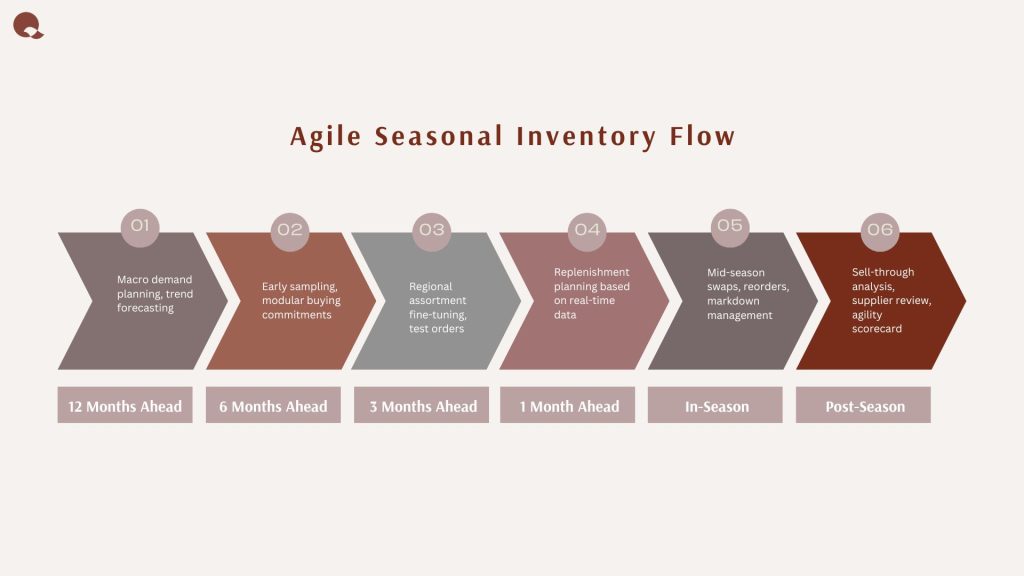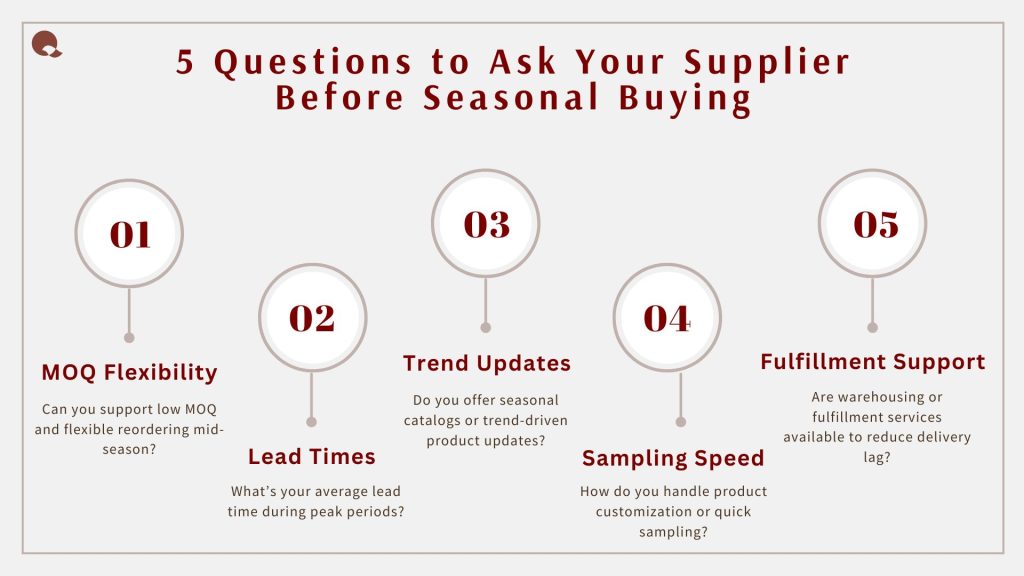
Inventory agility: Why seasonal flexibility is key to retail growth in 2025
etailers heading into the latter half of 2025 face a high‑stakes environment: global retail sales are projected to reach around $5.48 trillion, with growth of approximately 3.7 %, yet success will favor those who can treat inventory as a dynamic, adaptive asset rather than a fixed forecast. Meanwhile, 70% of retailers cite inflation, labor shortages, tariffs, and lingering supply chain shocks as their greatest operational challenges, underscoring how agile inventory strategies are essential to resilience.
In this context, agile inventory management becomes a competitive edge. Retailers must shift away from static, six‑month forecasts and embrace flexibility to react in real time to demand shifts driven by viral trends, weather shifts, and economic uncertainty. At the same time, 82% of supply‑chain organizations increased IT spending in 2025, reflecting the industry’s pivot to advanced analytics, cloud platforms, and integrated forecasting tools to support dynamic replenishment and allocation decisions.
Seasonal flexibility is no longer optional; it’s mandatory. The margin for error in seasonal alignment is tight, promotions are unpredictable, and consumer behavior is increasingly volatile. Forward-thinking retailers are integrating financial planning, demand forecasting, pricing, promotions, and store inventory into end-to-end systems to enable mid-season adjustments and maximize margin performance.
This is where Qalara helps businesses build true inventory agility. With low MOQs, short lead times, and seasonally refreshed product catalogs across categories, from home decor to fashion accessories, Qalara enables retailers to adapt quickly, test new collections with minimal risk, and replenish on the fly. The platform’s digital-first, integrated approach supports efficient planning, ensuring you’re not locked into outdated inventory when consumer tastes evolve mid-season.
In the sections that follow, we’ll unpack why seasonal flexibility should anchor your inventory strategy in 2025 and how it can fuel smarter sourcing, faster adaptation, and stronger retail growth.
• What is Inventory Agility?
Inventory agility is the ability of a retailer to respond rapidly and effectively to shifts in consumer behavior, seasonal demand, and emerging market trends. Rather than relying on rigid forecasts, agile retailers treat inventory not as a fixed plan but as a fluid variable, constantly adjusted via real-time data, automated replenishment, and flexible sourcing channels.
Unlike inventory accuracy, which measures how closely recorded stock matches physical inventory, often benchmarked at 95–99%, and lean inventory, which emphasizes waste reduction through minimal buffer and just‑in‑time delivery, inventory agility prioritizes responsiveness over efficiency. While lean practices reduce cost, they can leave retailers vulnerable to disruptions or sudden demand spikes. In contrast, agility accepts some holding costs in exchange for speed, resilience, and the ability to pivot mid‑season through flexible contracts, multiple suppliers, buffer stock, or postponement strategies.
McKinsey found that organizations excelling in agile practices deliver 7 percentage points higher service levels and hold 23 fewer inventory days than less agile peers. Additionally, agile business units bring products to market 40-50% faster, drive 30% greater frontline productivity, and are 1.5× more likely to outperform competitors on both financial and operational metrics.
• Why Seasonal Flexibility Matters in 2025
1. Shorter trend lifecycles
Social media and viral commerce continue to accelerate trend rotation; Target, for example, shortened its go‑to‑market timeline for trending items from 27 weeks to just eight weeks to catch fast-moving demand spikes. In sectors like fashion and home decor, this means shelf windows are narrowing. Retailers must increasingly pivot to small-batch buys and rapid restocking cycles, ensuring they don’t miss fleeting opportunities or carry outdated SKUs.
2. Supply chain disruptions
Supply chain instability remains a serious risk: 76% of European shippers experienced delays in the past year, and global disruptions now cost firms over $184 billion annually. Over 12% of retailers have reported severe disruptions in the past 12 months. In this volatile climate, rigid pre-season orders are highly vulnerable. Seasonal flexibility, with alternate sourcing routes and modular ordering, enables mid-season adjustments as tariffs, port congestion, or geopolitical issues crop up.
3. Data‑driven decision making
In 2025, real-time analytics is a strategic linchpin: 80% of firms now rely on data for faster decision-making, and analytics-led retailers bring products to market around 20% faster than their peers. Accurate forecasting tied to ERP systems, real-time sell-through data, and social trend signals allows businesses to reallocate inventory mid-season, optimize replenishment, and minimize overstock scenarios. When demand trends shift, whether due to weather, events, or viral content, retailers that align sourcing cycles with up-to-the-minute data can maintain margin control and customer relevance.
• Strategies to Build Inventory Agility
A. Modular planning & replenishment
Adopt a modular replenishment structure: buy small batches early, and top up as demand becomes clearer. This strategy prevents overstock while enabling rapid restocking if trends shift. Collaborative methods like Vendor‑Managed Inventory (VMI) or CPFR (Collaborative Planning, Forecasting & Replenishment) with suppliers support shared visibility and flexible restocks, reducing risk and bullwhip effect through real‑time coordination.

B. Vendor flexibility
Diversify sourcing with partners who offer low MOQs, short lead times, and multiple micro-batches. Qalara can prove to be a great option in this regard. Retail executives are increasingly investing in nearshoring and multi-shoring to avoid reliance on a single supplier base, especially in light of tariff and geopolitical volatility. For example, fashion brands are reshaping manufacturing footprints, pairing AI forecasting with agile supplier networks to simulate tariff impacts, optimize sourcing, and sustain margins.
C. Use of predictive analytics
Leverage advanced AI and ML tools to forecast demand using social data (e.g. influencer trends), weather analytics, historic sales, and macroeconomic indicators. Retailers like Target and Walmart are already using AI to double forecasting coverage, detect local shifts, and automatically rebalance stock across regions. Predictive analytics reduces stockouts and overstock by anticipating demand swings and enabling dynamic replenishment cycles.
D. Cross‑category seasonal swaps
Adopt a versatile sourcing strategy that shifts between seasonal categories, such as stocking outdoor furniture in spring, then pivoting to cozy throws or accessories in winter. Working with suppliers who can adjust assortments seasonally (e.g., plants vs. home textiles vs. lifestyle goods) helps optimize shelf space and seasonal appeal. This flexibility enables retailers to rotate offerings more dynamically and maintain relevance all year. Qalara offers a wide variety of on-trend products across multiple categories and can prove to be crucial for practicing this agility tactic!
• Why These Strategies Work in Tandem?
Together, modular replenishment, supplier flexibility, predictive analytics, and seasonal assortment swaps create a holistic agility engine. Combined with CPFR or VMI frameworks, retailers can share demand visibility with suppliers, dynamically adjust orders mid‑season, and minimize misalignment between forecasts and actual selling conditions.
This strategic synergy enables retailers to reduce lead time, control costs, avoid markdowns, and respond rapidly to demand shifts: key strengths for thriving in the fast‑changing retail climate of 2025.
• The Role of Sourcing Platforms in Enabling Agility
Sourcing platforms play a pivotal role in helping retailers achieve inventory agility. As trend cycles shorten and demand patterns shift more frequently, traditional procurement models, built on bulk buying and long lead times, can no longer keep pace. Modern digital sourcing platforms offer solutions through low minimum order quantities, quick sampling, and access to seasonally updated product assortments, allowing retailers to test and replenish inventory more dynamically.
Additionally, these platforms often integrate real-time inventory tracking, demand forecasting tools, and multi-supplier access, which collectively enable faster decision-making and more responsive buying. Some also provide warehousing and drop-shipping capabilities, helping retailers avoid overstock and reduce fulfillment time. By consolidating sourcing, logistics, and data into one ecosystem, sourcing platforms are empowering even smaller retailers to respond with the same agility once reserved for global giants, bridging the gap between scale and speed in today’s competitive retail environment.

Qalara, being one such platform leading this shift, is a digital sourcing solution designed to meet the evolving needs of agile retail. Qalara enables buyers to source with ease through low MOQs, quick sampling, and a wide selection of curated seasonal collections spanning home decor, lifestyle, fashion accessories, and more. Its supplier network, spread across India and Southeast Asia, supports both small-batch trial orders and scalable repeat production, making it ideal for businesses operating in dynamic retail cycles.
Beyond product access, Qalara offers integrated services such as quality assurance, customization, warehousing, and global fulfillment, allowing retailers to consolidate their sourcing and logistics through a single platform. With a tech-enabled dashboard that provides real-time visibility into inventory, order tracking, and production timelines, Qalara helps brands respond quickly to market trends, reduce overstock risk, and streamline replenishment. For retailers looking to scale smartly and stay seasonally relevant, Qalara provides the infrastructure to do it with speed and precision.
• Future-Proofing Growth with Flexibility
Inventory agility is no longer a nice-to-have; it’s a business imperative in 2025. With shrinking trend lifecycles, unpredictable demand patterns, and ongoing supply chain disruptions, retailers must embrace flexibility in how they plan, buy, and replenish stock. Seasonal adaptability, modular buying, and real-time decision-making are now core capabilities that separate thriving businesses from those stuck in outdated cycles.
To stay ahead, retailers should re-evaluate their seasonal calendars, build relationships with agile suppliers, and lean into digital tools that support responsive sourcing. Platforms that offer low MOQs, diverse seasonal collections, and scalable operations will be critical to driving sustained growth.
Ready to future-proof your sourcing strategy? Explore Qalara, a smart, flexible sourcing solution built for modern retail agility.
~ Written by Shambhavi






Leave a Reply